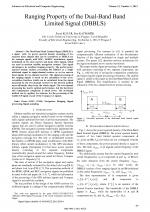| 3/2012 - 14 |
Ranging Property of the Dual-Band Band Limited Signal (DBBLS)KOVAR, P. |
| Extra paper information in |
| Click to see author's profile in |
| Download PDF |
Author keywords
BOC, GNSS, navigation, ranging, signal processing, signal sampling
References keywords
navigation(6), gnss(6), galileo(5), signal(4)
Blue keywords are present in both the references section and the paper title.
About this article
Date of Publication: 2012-08-31
Volume 12, Issue 3, Year 2012, On page(s): 89 - 96
ISSN: 1582-7445, e-ISSN: 1844-7600
Digital Object Identifier: 10.4316/AECE.2012.03014
Web of Science Accession Number: 000308290500014
SCOPUS ID: 84865853740
Abstract
The Dual-Band Band Limited Signal (DBBLS) is a signal with its power spectral density consisting of two separate lobes. Signals that can be considered as DBBLS are for example signals with BOC, AltBOC modulation, signals modulated on two close carriers and many other signals, which are used in modern satellite navigation systems. This signal advantage is its excellent ranging property. The parted power spectral density enables processing the DBBLS as a single wideband signal in single-channel receiver or as two narrow band signals in two-channel receiver. The signal processing of the ranging signals is based on the calculation of the cross-correlation function, which can be calculated from the signal measured by the two-channel receiver by the derived method more efficiently than from the whole signal. The two-channel processing has nearly optimal performance, but the hardware and computation complexity is much lower. The developed method can by applied, for instance, for the processing of the Galileo E5 signal or pair of the Compass L1 signals. |
| References | | | Cited By |
Web of Science® Times Cited: 0
View record in Web of Science® [View]
View Related Records® [View]
Updated today
SCOPUS® Times Cited: 0
View record in SCOPUS® [Free preview]
There are no citing papers in the CrossRef Cited-by Linking system.
Disclaimer: All information displayed above was retrieved by using remote connections to respective databases. For the best user experience, we update all data by using background processes, and use caches in order to reduce the load on the servers we retrieve the information from. As we have no control on the availability of the database servers and sometimes the Internet connectivity may be affected, we do not guarantee the information is correct or complete. For the most accurate data, please always consult the database sites directly. Some external links require authentication or an institutional subscription.
Web of Science® is a registered trademark of Clarivate Analytics, Scopus® is a registered trademark of Elsevier B.V., other product names, company names, brand names, trademarks and logos are the property of their respective owners.
Faculty of Electrical Engineering and Computer Science
Stefan cel Mare University of Suceava, Romania
All rights reserved: Advances in Electrical and Computer Engineering is a registered trademark of the Stefan cel Mare University of Suceava. No part of this publication may be reproduced, stored in a retrieval system, photocopied, recorded or archived, without the written permission from the Editor. When authors submit their papers for publication, they agree that the copyright for their article be transferred to the Faculty of Electrical Engineering and Computer Science, Stefan cel Mare University of Suceava, Romania, if and only if the articles are accepted for publication. The copyright covers the exclusive rights to reproduce and distribute the article, including reprints and translations.
Permission for other use: The copyright owner's consent does not extend to copying for general distribution, for promotion, for creating new works, or for resale. Specific written permission must be obtained from the Editor for such copying. Direct linking to files hosted on this website is strictly prohibited.
Disclaimer: Whilst every effort is made by the publishers and editorial board to see that no inaccurate or misleading data, opinions or statements appear in this journal, they wish to make it clear that all information and opinions formulated in the articles, as well as linguistic accuracy, are the sole responsibility of the author.



